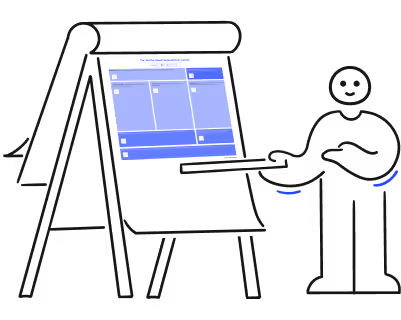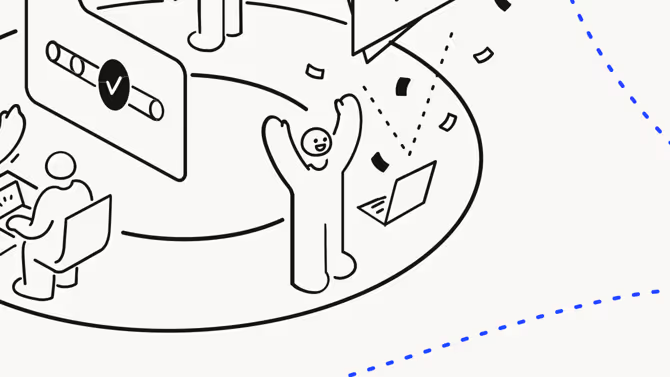How to build career growth plans for your team members

Empower your organization with the skills-based canvas.

Growing your people grows your business. But employees can’t move forward without clarity. They want direction, opportunity, and support. And effective career growth plans are key.
A strong plan helps every employee develop career goals and outline their path. It connects short-term wins to long-term aspirations, turning ideas into actionable milestones. When your team has clear expectations and the right resources, they’ll be more motivated and focused on professional development.
In this guide, we’ll break down how to develop a career plan that fosters growth and keeps your team moving toward bigger and better targets.
What’s a career growth plan?
A career growth plan is a document that helps employees define their professional goals and outlines how to achieve them. For example, a team member might aspire to become a department head at their company. A career plan would offer a structured route to that destination, clearly laid out targets, training, required education, and milestones.
Strong plans place the responsibility for growth on employees themselves. Instead of asking managers what the next step in their career trajectory is, employees can check their growth plan and make informed decisions. This sense of autonomy and direction makes teams more confident and motivated to work toward the next step.
Here’s why developing a career strategy matters for employees:
- Clarity and direction: Vague expectations are disheartening and might make promotions look unachievable or even random. A clear career plan provides employees with visibility into progression, with concrete objectives to show the next steps.
- Continuous development: Technology and industries evolve rapidly, and without regular professional development, teams can quickly fall behind. Growth plans encourage ongoing learning and skill set improvement to stay competitive.
- Motivation and commitment: When they’re stuck in the same role for a long time, people can feel like they’re stagnating. Knowing they’re working towards a larger goal furthers motivation.
- Recognition and reward: Feeling like your hard work goes unnoticed can be frustrating. Career growth plans help employees understand how accomplishments contribute to advancement.
Using an LMS platform makes this process seamless by helping teams turn company knowledge into best practices with dynamic training content. It gives leaders the tools to support career growth without building programs from scratch. Plus, employees can access curated learning paths and own their career goals while managers track progress, all in one place.
What’s the difference between a career growth plan and a career development plan?
Career growth plans focus on the big picture, like long-term career goals. They’re about achieving major career goals like promotions and outlining the steps required to get there.
Career development plans are more tactical, focusing on specific skills and learning development opportunities. They often include actionable objectives like improving networking abilities or obtaining an accounting certification. Unlike growth plans, they don’t factor in high-level objectives.
They’re different, but the two plans work very well in tandem. A growth plan can even encompass a development plan as part of its goal-setting strategy. For example, skills gained through a development plan could be crucial to reaching the next step of a growth plan. By using both together, employees can better reach their potential.
6 career growth examples
Everyone has different career goals, so growth plan steps vary. But here are six common career development planning examples that you might see on a career growth plan:
- Earning a promotion: Progressing to a more senior role is a clear indicator of career growth. Promotions also create momentum across teams, as seeing someone advance reminds colleagues that progression is possible.
- Moving sideways into a new role: Transferring into a different position at the same level, or moving laterally within a company, builds new skills and challenges ways of thinking. Employees can assess their strengths and identify and bridge any skills gaps based on new responsibilities, helping prepare for future career goals.
- Taking part in training: Formal and informal training prepares individuals to achieve their more ambitious career goals. Workshops and online learning sessions accelerate employee growth by expanding skill sets.
- Working with a mentor: Mentorship connects employees with a senior who offers guidance, support, and advice on how to advance. These relationships make long-term career goals feel more achievable.
- Exploring cross-functional projects: Collaborating with other departments helps employees develop a broader perspective. Understanding business operations in a wider context is often crucial in more senior roles. Individual projects offer a way for employees to see this context at a smaller scale before they advance.
- Seeking out sponsorship: Training and education can sometimes be too expensive to pursue alone. Sponsorship opens doors to roles and opportunities your team members may not be able to access otherwise.
Supporting employees through career planning is an excellent way to keep them motivated and engaged. When people feel like they’re progressing at an organization, they’re more likely to stick around and aim higher.
Development and career planning for your team
Helping employees create actionable career plans sets them up for success. Here are some tips for managers who want to create plans that guide their teams.
Assess employee strengths and interests
Get to know employees’ skills, passions, and career aspirations. Use feedback and open conversations to discover what drives them. When your team members feel seen and understood, their career goals may become clearer, which skyrockets motivation.
Define short and long-term career goals
Break down career goals into short-term goals and long-term aspirations. Achievable short-term targets help keep up momentum, while long-term planning gives employees a well-thought-out route toward grander objectives.
Map out skill development opportunities
Developing a broader skill set is an essential part of career growth. Look for training programs, certifications, and cross-departmental projects to help employees expand their capabilities. They’ll have the skills they need to progress, and you’ll have a workforce that’s more adaptable and resilient.
Introduce mentorship and coaching
Mentorship and coaching accelerate career growth by connecting employees with leaders who’ve walked in their shoes. Pair team members with mentors who can share performance insights, give feedback, and open doors.
Use tools to personalize career paths
Every career is different, so personalization matters. With Workleap Skills, managers can map employees’ skills, create tailored career paths, and plan for success, all powered by AI automation. It's a scalable tool that supports professional development and helps workers achieve long-term career goals faster.
Set measurable milestones
Set clear, measurable objectives that tie directly to employees’ career plans. Reaching milestones builds confidence and a strong sense of achievement and purpose. Examples might be completing a training course or leading an important project.
Regularly review and adjust the plan
Careers evolve and plans change, so make sure strategies aren’t static. Schedule regular check-ins to assess employees’ progress and tweak targets according to shifting career goals. Staying flexible helps workers feel heard and supported, building trust.
Recognize wins and celebrate progress
Recognize employees’ achievements, like completing a training program or getting a promotion, and celebrate these wins with the team. Acknowledging and celebrating progress publicly reinforces the value of career growth and creates a culture that rewards success.
Why is it important to regularly review and update career growth plans?
A career growth plan isn’t just “set-it-and-forget-it.” Goals shift, opportunities come and go, and industries evolve overnight. Encourage employees to update plans and targets regularly.
When managers schedule regular check-ins, they create space to reassess priorities and explore new growth opportunities. Overseeing career plan updates helps employees stay focused and open to change.
Here are four ways regular career growth plan updates can help employees:
- Adapt to industry changes: Thanks to technological and industry advancements, many job roles are constantly evolving. Reviewing career plans regularly helps employees identify new skills and training programs to stay competitive in their sector.
- Build resilience: Career paths rarely follow a straight line. Regularly updating growth plans allows employees to recover from setbacks and confidently find a new route forward.
- Stay focused on career goals: The demands of day-to-day work can distract from long-term career goals. Regularly reviewing employees’ career plans can keep them motivated by reminding them that daily efforts contribute to long-term progression.
- Ask for guidance: Even with a plan laid out, employees can be confused about how to proceed. Frequent reviews allow them to ask for additional guidance while opening doors to mentorship and coaching opportunities.
How career growth plans drive engagement and retention
A clear career growth plan gives employees direction, purpose, and confidence in their future. It connects short-term goals to long-term ambitions, turning everyday work into meaningful progress.
When people understand how their efforts contribute to their growth—and feel supported along the way—they’re more engaged, motivated, and likely to stay and thrive within your organization.
%20(1).png)

%20(1).avif)


.avif)
.avif)


%202.avif)


.avif)


